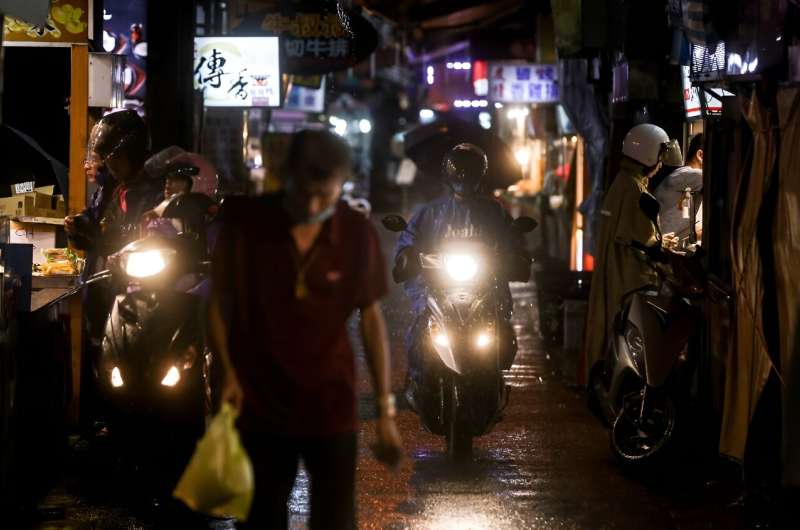This article has been reviewed according to Science X's editorial process and policies. Editors have highlighted the following attributes while ensuring the content's credibility:
fact-checked
reputable news agency
proofread
Typhoon Haikui makes landfall in Taiwan

Typhoon Haikui made landfall and moved across Taiwan Sunday, unleashing torrential downpours, whipping up winds and plunging thousands of households into darkness as the first major storm to hit the island directly in four years.
More than 7,000 people were evacuated from high-risk areas, hundreds of flights canceled and businesses closed in preparation for the storm.
Authorities reported that more than 40 people were injured from the storm, including at least two in mountainous Hualien county who were hurt after a falling tree hit a car.
Taiwan's Central Weather Bureau confirmed to AFP that the typhoon made landfall at 3:40 pm (0740 GMT) in coastal Taitung, a mountainous county in lesser-populated eastern Taiwan.
Residents hunkered down indoors in the dark, staying away from windows as strong gusts of wind sent fallen trees and dislodged water tanks flying in the air, according to an AFP reporter.
"I think this time it is serious," said retired mechanic Chang Jhi-ming, 58, in Taitung.
"This is just beginning, the wind is just coming in and you can see trees toppling already."
Some marveled at the sight of the massive waves around the harbor before Haikui made landfall.
"It's been a while since any typhoon landed here, only today can you see such waves. A rare sight!" said farmer Chen Hsin-kuang, 62.

More than 119,000 households lost power throughout the day as the typhoon swept through the southern and eastern regions, though over half saw it restored by nightfall.
By 9:00 pm Haikui had weakened to "moderate intensity" and was near Taiwan's southwestern Kaohsiung city, carrying sustained winds of about 126 kilometers (78 miles) per hour, said a Central Weather Bureau forecaster during a briefing.
"Heavy rains are expected in the mountains in Yilan, Hualien, Taitung, Kaohsiung and Pingtung tonight," said the forecaster.
The last major storm to hit Taiwan was Typhoon Bailu in 2019, which killed one person.
Haikui, the first storm in four years to cross the Central Mountain Range running north to south of the island, had the potential to wreak havoc by causing landslides and rockfalls on surrounding communities.
"I remind the people to make preparations for the typhoon and watch out for your safety, avoid going out or any dangerous activities," Taiwanese President Tsai Ing-wen said.
'Big winds'
A fishing harbor in northeastern coastal Yilan county saw towering waves slam against the shore, as residents huddled under umbrellas to shield themselves from unrelenting sheets of rainfall.

Some braved the downpour to shop at a nighttime market that had remained open despite the authorities' warning of possible flash floods.
In Taitung, ripped-up trees already littered the streets before Haikui landed, street signs swayed under the strong winds and a restaurant owner tied down his sign advertising seafood.
"I almost forgot what it's like to be in a typhoon. What big winds!" restaurant owner Huang Jun-tong said, adding that when he woke up he immediately went to his shop to make sure everything was protected.
"Yesterday, it was so calm that we did not feel like a typhoon was coming. Today, we feel it," he told AFP.
The military had mobilized soldiers and equipment, such as amphibious vehicles and inflatable rubber boats, around the parts of Taiwan where Haikui was expected to have the heaviest impact.
But it is expected to be less severe than Saola, which bypassed Taiwan but triggered the highest threat level in nearby Hong Kong and southern China before it weakened into a tropical storm by Saturday.
© 2023 AFP





















